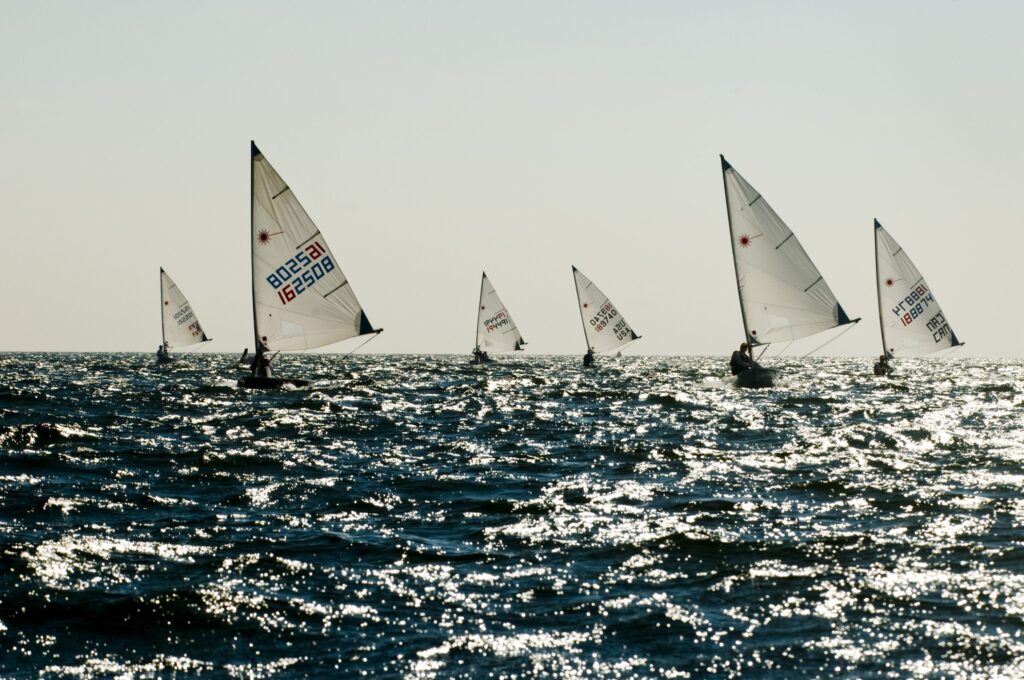Many people often ask us how the downwind style has changed over the years. Here's a quick summary of what modern downwind sailing is like and how to achieve it.
When there are no waves (and sometimes with waves) the quickest way to the bottom mark can be upwards of 30 degrees off of DDW (dead downwind). How does this make sense? If you are traveling at a higher speed away from the rhumb line and similar speed back to the mark than a boat traveling straight downwind going slower, you can arrive at your destination sooner. This speed justification is called VMG (Velocity Made Good).
The acute angle sailed away from DDW can vary, but the reason for extra speed is always the same: more power in the sail, which contributes to increased resistance on the foils that coincide to create more boat speed. The increased pressure on the sail comes from having a low-pressure suction created by air flowing behind the sail. Basically, if you can see your telltales on the leeward side flowing toward the mast (when sailing by the lee) or towards the leach (when broad reaching), you know that the pressure in your sail has increased by over 50%. This is the first step towards experimenting with VMG. The lighter the condition, the bigger the angle that is required to maintain the airflow behind the sail. As wind increases, we can usually see those angles become narrower.
If we can get to the mark faster simply by increasing pressure on the sail, we can do even better if we can catch waves. Catching a wave would mean that we no longer need to sail 30 degrees off of DDW to go “X” speed, if we are surfing, we can go the same “X” speed but directly toward the mark. This element changes VMG. The only issue is that surfing isn’t 100% sustainable, even when it is, we sometimes run into the back of other waves, or need to sail angles again to get enough speed to catch waves. Objectively we’re trying to a) increase power in sail by sailing angle that allows for flow on the leeward side, so that b) catch wave toward the mark.
Learn this in our downwind clinics
In order to get an edge on the competition, you need to be hitting the optimal angles for maximum power and short duration to repetitively catch the ideal waves as you surf your way through the fleet. Eventually, this means not turning to 30 degrees from DDW every time you want a wave. As your speed increases, your angles decrease. Meaning you can power your sail with minimal angle change as you connect waves. The last part that ties it together is:
Rocking the boat is by far the most important part of the sequence. Every time you turn the boat to increase sail pressure, it is initiated with heel in the boat, not rudder. For two reasons; 1. using rudder is slow! if it is your main mode of steering downwind, you will miss 50% more waves as it adds drag. 2. most importantly, rocking moves your sail through the air, which creates more velocity across the backside of the sail which increases the pressure in the sail, making it effortless to catch waves without making huge-angle changes.

Training for downwind sailing at ISA in Mexico. Read about our downwind clinics.
Rocking is not permitted unless “rolled to facilitate steering”, however, “Repeated rolling not linked to wave patterns is rocking prohibited by rule 42.2(b), even if the boat changes course with each roll.” This means you must push the kinetics to get the most out of the boat, but make sure your cadence and rhythm make sense!
To make some legitimate gains on downwind speed, there is a lot more to learn than just the theory of WHY people sail lasers the way they do. The actual techniques take a lot of body position tweaking, varying mainsheet tensions and hours of repetition. If you’d like to explore downwind sailing in greater depth, join us for one of our famous 6 day downwind camps.